Common Name(s): Bald cypress, swamp cypress, sinker cypress, pecky cypress, and tidewater red cypress
Scientific Name: Taxodium distichum
Distribution: Southeastern United States
Tree Size: 80-120 ft (24-37 m) tall,
3-5 ft (1-1.5 m) trunk diameter
Average Dried Weight: 32.0 lbs/ft3 (515 kg/m3)
Specific Gravity (Basic, 12% MC): 0.42, 0.51
Janka Hardness: 510 lbf (2,270 N)
Modulus of Rupture: 10,600 lbf/in2 (73.1 MPa)
Elastic Modulus: 1,440,000 lbf/in2 (9.93 GPa)
Crushing Strength: 6,360 lbf/in2 (43.9 MPa)
Shrinkage: Radial: 3.8%, Tangential: 6.2%,
Volumetric: 10.5%, T/R Ratio: 1.6
Color/Appearance: Color tends to be a light, yellowish brown. Sapwood is nearly white. Some pieces can have scattered dark pockets and voids where the wood has been attacked by fungi—called pecky cypress. Also, pieces of old growth cypress salvaged from riverbeds (called sinker cypress) tend to have slightly warmer, darker heartwood colors.
Grain/Texture: Straight grain and medium to coarse texture. Raw, unfinished wood surfaces have a greasy feel.
Rot Resistance: Old-growth bald cypress is rated as being durable to very durable in regards to decay resistance, while wood from younger trees is only rated as moderately durable.
Workability: Sharp cutters and light passes are recommended when working with bald cypress to avoid tearout. Also, the wood has been reported by some sources to have a moderate dulling effect on cutting edges. Bald cypress has good gluing, nailing, finishing, and paint-holding properties.
Odor: Bald cypress has a distinct, somewhat sour odor while being worked.
Allergies/Toxicity: Although severe reactions are quite uncommon, bald cypress has been reported as a sensitizer. Usually most common reactions simply include respiratory irritation. See the articles Wood Allergies and Toxicity and Wood Dust Safety for more information.
Pricing/Availability: Prices ought to be in the mid-range for domestic woods, with clear, knot-free boards for woodworking applications costing more than construction-grade lumber. Also, specialty lumber such as reclaimed sinker cypress or pecky cypress is much more expensive.
Sustainability: This wood species is not listed in the CITES Appendices, and is reported by the IUCN as being a species of least concern.
Common Uses: Exterior construction, exterior furniture, docks, boatbuilding, interior trim, and veneer.
Comments: Bald cypress is the state tree of Louisiana, and is an icon of southern swamplands. So named because the trees are deciduous (unlike most conifers), and have the peculiar trait of dropping all their needle-like leaves each winter.
The trees also develop unique aerial roots that protrude above the ground (or water) and are especially seen on trees growing in swamps. These structures are known as knees, and are sometimes harvested on a small scale and sold for woodcarving purposes (see picture below).
Although not technically a cypress in the strictest sense (see my comments on overly strict naming practices in my article on cedar woods), the wood of Taxodium distichum is simply called cypress (with no other qualifiers) throughout North America. The tree is in the Cupressaceae (cypress) family, which also includes many decay resistant woods (including cedars), and the wood is a popular choice in exterior construction applications where decay resistance is needed.
Images: Drag the slider up/down to toggle between raw and finished wood. The first sample is a more standard new-growth piece of bald cypress, while the second pictured sample is of old-growth bald cypress.
The image of the pecky cypress interior comes from a 1955 sales catalog from the Southern Cypress Manufacturer’s Association.
Identification: See the article on Softwood Anatomy for definitions of endgrain features.
Resin canals : absent
Tracheid diameter : large to very large
Earlywood to latewood transition : abrupt (can be more gradual in newer-growth pieces)
Grain contrast : moderate
Parenchyma : none
Lookalikes/Substitutes: Bald cypress can sometimes be confused with other softwoods, especially pine growing in overlapping geographic areas. Bald cypress is easily separated from pines anatomically by its lack of resin canals.
Notes: Like many other softwoods, anatomical features of bald cypress can vary greatly depending on the growing conditions and age of the tree. Endgrain photos of both younger new-growth, as well as old-growth bald cypress are included. In general, older-growth wood will have more grain contrast, and a more abrupt transition from earlywood to latewood.
Related Content:





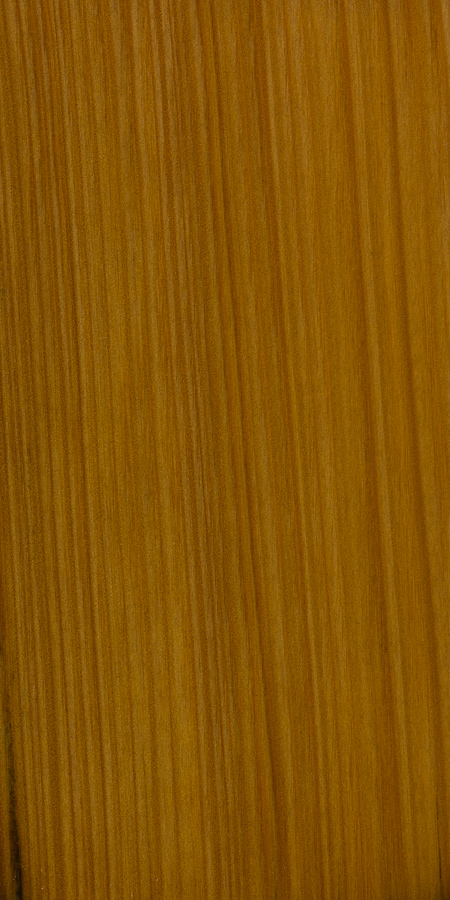
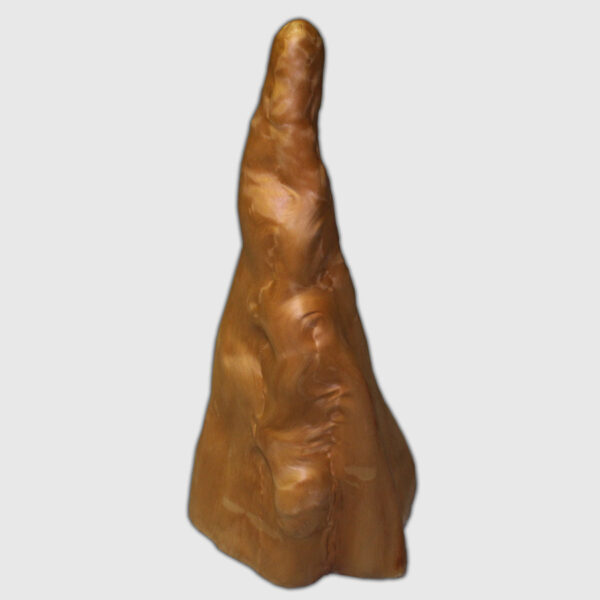


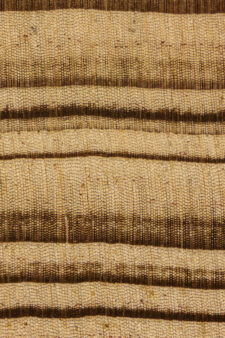


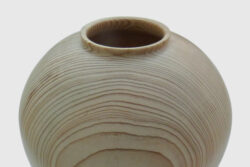

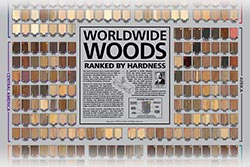
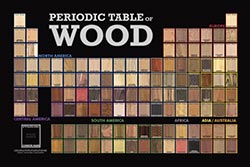

Sinker cypress is the most beautiful wood in the world. Manuel Sinker Cypress.
12′ Cypress table made from a 21′ long x 62″ wide single slab that came from a double barrel tree. That’s two trees that grew together, which means it had a beautiful stripe of quilting running right down the middle. The base is steel.
what did you finish your table with – oil? poly? clear? or tinted? its beautiful.
I am making a desk/table as a graduation gift for my son. The top will be about 30″ X 45″ made out of 7/8″ quarter sawn Sycamore with a Canary wood trim. The legs, box legs with a center support are made out of 3/4″ thick X 7″ wide X 24″ long sunken cypress, Bald Cypress. They are attached to some old 10″ cast iron claw legs. I was told the Cypress was a harder wood as it was under water for so long that it collected minerals to make it harder. And the tight grain. I was apprehensive when… Read more »
I just posted a picture of a dining room table made from sinker cypress. Sinker is harder mainly because its old growth. If you think it will get hard use, you might consider coating it with resin which will soak into the wood and firm it up. You wont be able to use an oil finish, but a sprayed on conversion varnish will stick to the resin and it allows you to change to sheen to anything you want. The edge of my table was very soft, so I brushed on resin and the wood soaked it up an made… Read more »
I’m building a 16’x28′ pavilion with large timber. 8″x8″x10′ post 8″x12″x30′ beams and 4″x10″x16′ rafters. My question is, I can get cypress or Atlantic white cedar close by for almost the same price, which is better and why? Dose one check or warp less when drying? Both green.
Thank you for a well-done & very useful website. I am in the Northern Kentucky / Cincinnati area and am preparing to purchase a swing-bed for my screen porch (which is on the “weather” side of the house.) The maker’s selection includes sapele, teak or cypress. I am extremely conscious of the issues with Myanmar and would prefer to not contribute to human rights abuses nor the carbon footprint associated with shipping. Like most people, I REALLY want a wood that will resist rot. I will take care, but am certain it will occasionally end up wet. I am 64… Read more »
Hi — I have built Adirondack chairs from South Carolina rough cut cypress for 20+ years. Mostly put 3 coats of spar varnish on them. These have been for gifts and for my own use. My observations of them have been as follows: 1) put them in the yard on the ground and they last maybe 3-5 years; 2) put them on a deck in the rain and they will last maybe 10 years; 3) put them on a covered porch where they occasionally get wet from blowing rain and they last indefinitely.
I came into a number of cypress slabs 3 to 4 inches thick. Is this wood good for making cutting boards, knife racks, and furniture? I’ve read that the Janka scale is 510, but not sure what this means or how it compares. What would be a good use for this wood?
Probably too soft for cutting boards. Maybe a fireplace mantel? Otherwise you could use it for outdoor furniture.
Can Cyprus wood be used to make an apple pulper?
Has anyone used cyoress for carvong spoons? I was thinking about it any info would be great.
Cypress makes a beautiful spoon but it is very soft and not a great choice for a spoon that will be used regularly. It would be better served as a decorative piece.
Many of the “Shotgun Houses” in New Orleans are constructed of this wood, and many are over 125 years or more old. They are said to be highly resistant to wood rot.
I believe old growth cypress like those in old New Orleans homes performs better than younger cypress (less heartwood cypressene).
Does anyone know how this wood works for the frame boxes for bee hives?
Rossman in Moultrie, Georgia sells hive bodies and supers made from bald cypress. There are some in my area that have been in use for 30+ years.
Excellent to outstanding
I would guess, “NO”, not recommended for frame of a bee’s hive. Bees would probably work right through this wood quickly, due to it being a ‘softwood’. Use walnut wood or redwood, much harder wood for framing a bee hive.
The bee boxes in our area are almost always made of this. They have been around on some of our back fields for 40+ years. I personally have used it for making a dock, outside planters, and a pool deck.
Hi. I have a piece of cypress already roughly shaped like an axe handle. I know it is not the strongest of woods, but would it still be an okay wood to use for an axe handle?
I would expect it to work but not for very long.
No. I live in Baton Rouge and am a professional woodworker. I use Cypress a lot and it is not a very strong wood. Your handle will eventually snap. It is a very soft wood.
I have been looking for a 6 ft cypress swing.
What is the average price range. I’m in Assumption Parish but haven’t been able to find one.. I bought one a couple of years ago under the pretense it was cypress and it rotted away. We didn’t have any knowledge of cypress.
I have templates for bateaus that were built with cypress from the area around Blountstown, Florida.
The early 50s & back was the heyday. In my shop I plan to build some from relatively fresh cut
cypress. Fasteners will be brass or stainless steel screws. Sides will be solid one piece & bottom will be
wide slats ( 4″ ) & left with gaps to expand & seal the bottom. Transom will be 1 & 1/2″ to accomotate
a small outboard or electric.
Any thoughts on sealing or finish? Nick
Does it resist termites?
Just visited some cypress trees on the Black River in North Carolina that are the oldest known trees east of the Rockies. The oldest one found so far has been core dated to 2,600 years old! The trees are not tall. They were once, but the tops were blown out by storms hundreds of years ago. Growth rings are so narrow and the heartwood is so compressed by centuries of stress that counting the rings can only be done under a microscope by an expert. I would love to get hold of a piece of salvaged ancient cypress heartwood big… Read more »
I have plenty projects here: https://www.facebook.com/pg/CajunCraftsman/photos/?tab=album&album_id=10151339157888350
Cypress has tropical oils in it that aide in rot resistance. I found the answer is to use shellac as a sealer first, and then poly as your top coats.
What are your thoughts on using rough cut cypress to replace a floor in a horse/stock trailer?
Don’t really have too much experience with horse trailers. The wood is rather soft, so not sure how it would hold up to the weight and wear, but at least it’s probably not for aesthetic purposes, so it may not be an issue that it is dented, etc.
Related tree is the Red Wood. I came across a source in a bookstore once that gave the height of the “Bald Cypress” as being up too 300 ft. (most texts list in in the mid to upper 100 ft range). The explanation of this one source was that it rarely gets to these heights anymore, but in earlier centuries old growth of the tree was much higher.
The tree is BEAUTIFUL. Graceful & willowy, the slightest breezes stir the branch-lets into slow dancing ripples of movement
I have found that quartersawn old growth bald cypress sapwood makes excellent instrument soundboards, particularly for acoustic guitars & ukuleles. The “tap tone” is pleasantly mellow and not overly bright. Very comparable to Alaskan Yellow Cedar but much cheaper.
i am making “the mother of all wedding benches” for my daughter out of a 30 yr old tree that a neighbor had to take down. i am very surprised that it is so light, having been making tables and such from pecan and mesquite and osage orange. just seems to me a very light wood would rot faster, but what do i know? ;-) the bench is 4-1/2″ thick, 15″ wide,6′ long, live edge. the legs are 1/4 vertical slices off the bottom 3′ of the trunk – which was too large for my friend to mill with his… Read more »
Thank you sir for the information.
I think most instances of allergic reactions occurred when breathing the sawdust. But with that being said, I don’t know about drinking liquids out of it — seems a bit much for the wood unless it’s finished in a food-safe epoxy, but I don’t have much experience in this area.
I am down in South Georgia where the cypress are quite abundant. Knowing the wood is light weight,rot resistant,and easy to carve, I thought it might make good material for making drinking cups and wooden bowls and plates. I checked you database for toxicity levels but it doesn’t say anything about drinking cups and such. Do you know if it is safe for drink and food?
Cypress is the woods used exclusively in NYC water towers.
The NYC water towers are typically made from western red cedar (giant arborvitae) for fire suppression only.
this type is very common in greece, durability is very good if there is any contact with huminidy or water, if it does in sort time it gets infected by worms/insects.
i have replace pieces in old houses that they were hard as iron,but they were also well protected by huminidy.
What’s old cypress siding worth?